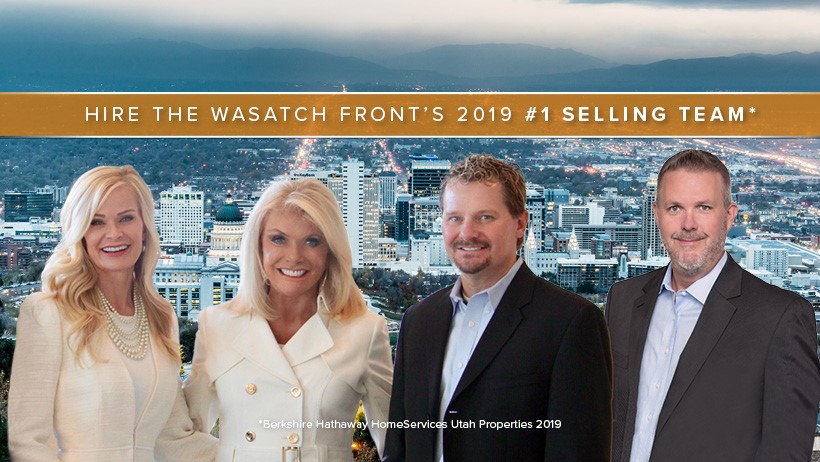How I visited all of Utah’s ‘Mighty Five’ National Parks in a single weekend
I had 72 hours, five parks to get to and one camera.
As I left my house at 7:30 a.m. on Sept. 18, my editor’s words that some parts of this trip may be “too ambitious” echoed in my head.
But I didn’t have time to worry if I could get it all done. I had driving to do.
In mid-September, I undertook a reporting trip that required me to drive nearly 1,000 miles over southern Utah to see all five of Utah’s National Parks: Arches, Canyonlands, Capitol Reef, Bryce Canyon and Zion National Parks.
Why?
I was on the hunt for lived experience. I went to see for myself what some of my sources could only attempt to describe over the phone. I went to talk to people who have come from all over the country, and the world, to adventure in the desert. I went to better understand the places I talk and think about every day, and ultimately become more of a local.
What did I find?
Unbridled Americana, wide-open sanctuaries, an exhaustive child-like wonder, heartbreaking loss, adrenaline-filled adventure, deafening silence, hidden treasure and a human community I thought was lost due to the societal effects of the COVID-19 pandemic.
Also, there was the altitude sickness and a flat tire, but that’s beside the point.
So how did I do it all?
Well, it all started in Moab, Utah.
Arches National Park
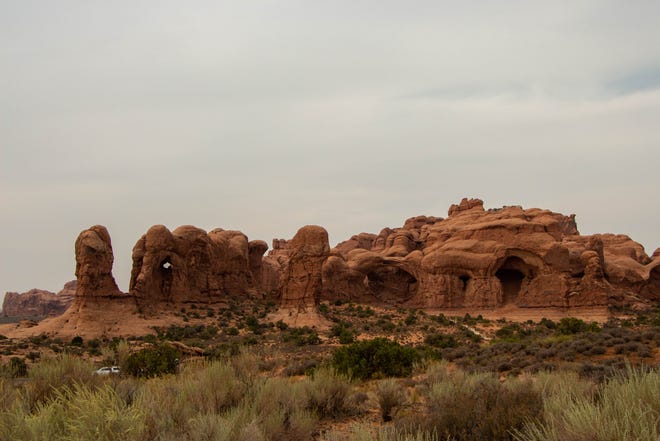
I left St. George at basically dawn and pulled into Moab in the early afternoon on a Friday, flashed my national parks interagency annual pass at the gate, and sat in the Visitor Center parking lot at Arches National Park setting up my gear.
After spending some time shopping for irresistible trinkets, I met with Chief Ranger Melissa Hulls and some of her colleagues.
Arches was been inundated with heavy traffic this September, forcing rangers to close the main gates for hours nearly every day.
“I think people have gotten stir crazy. Just with everything going on with COVID. It’s great that they want to get outdoors. It’s great that they want to experience their national parks and maybe come to areas they wouldn’t have otherwise. So it’s great to see the people here, it’s just a challenge sometimes to manage the number of people that come here,” Hulls said.
After our chat on camera, I explored the park myself to see what all the hype was about. And boy, is it well deserved.
WATCH THE VIDEO:Interview with a Ranger: Why Arches National Park has an overcrowding problem
Cruising the switchback and up through Balancing Rock, The Windows, The Garden of Eden and ultimately the famous Delicate Arch, I found myself pulling over every two minutes to take a photo.
I hiked the Upper Delicate Arch Viewpoint Trail to see the iconic arch on everybody’s license plate in person.
Except, I forgot about altitude. Moab has an elevation solidly 2,000 feet higher than St. George. And as I had spent the past four years of my life living at sea level, I felt like I was on a boat in the middle of the desert.
I found a kinship of other travelers on the trail, masked and unmasked, who were also struggling with the altitude. Chuckling, we cheered each other on and sighed at those who literally ran up the trail without breaking a sweat.
I forgot how nice it is to laugh and talk with strangers.
After my hike, I drove to my hotel in Moab, while fighting through construction and stand-still traffic, and spent the evening walking around downtown.
While waiting for my takeout from local favorite Pasta Jay’s, I was struck by just how many people were outside walking the town. It actually felt like pre-COVID times, except half of the population was wearing masks, and half not. Still, it was a bustling “city” humming with chatter, laughter, and the pitter-patter of tourist feet.
I bolted out of the door at 7 a.m. the next morning, hoping caffeine would save me as I went to go wait for Arches to close. Ironic, no?
Sitting in the Windows parking lot, people waved, asked how I was what I was up to with my tripod and glaring orange press pass. I watched families uproariously laugh as they reunited to enjoy the outdoors together. Again, I forgot what it was like to be in public.
I moseyed on over to Delicate Arch when the flashing red and blue lights shot through me and I realized it was just Hulls, closing the Delicate Arch parking lot and waving people on.
“The park closed 15 minutes ago,” she said.
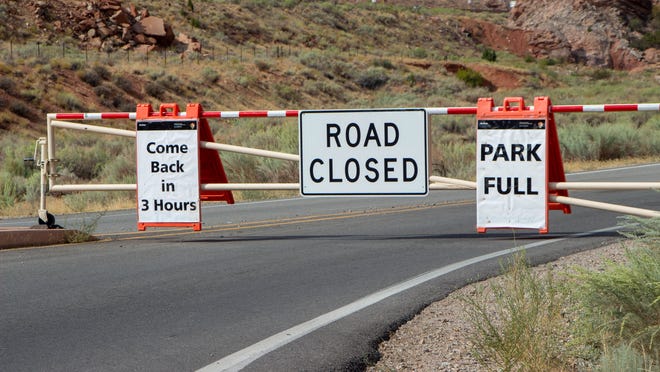
Frenzied, I raced back to the entrance and finished up my story, talking to the rangers turning people away, and the disappointed travelers trying to figure out what to do instead.
READ MORE: Arches National Park has an overcrowding problem, causing 3-hour closures almost daily
Canyonlands National Park
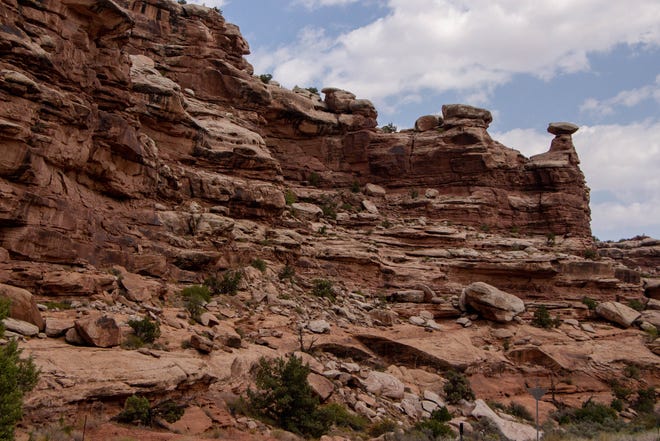
When Arches closes, rangers tend to send travelers to Canyonlands National Park, just a 30-minute drive away. So, I went too.
Something completely overlooked when speaking of the Mighty Five is how absolutely stunning the scenery between the parks are. In some ways, I enjoyed my time driving in awe just as much if not more than my time in the parks.
Except, even there we waited for nearly 45 minutes to get into the park as there’s only one shack as an “entrance gate” to Canyonlands. Arches receives more than double Canyonland’s visitation annually, so some facilities do not have to be as grand.
Once inside, rangers at the visitor’s center guided me to the most popular places in the park, but specifically the northern Island in the Sky region.
After a drive-through and a few pictures, and though I was sad I couldn’t spend more time in Canyonlands, It was 2 p.m. and I had to get to Capitol Reef.
Capitol Reef National Park
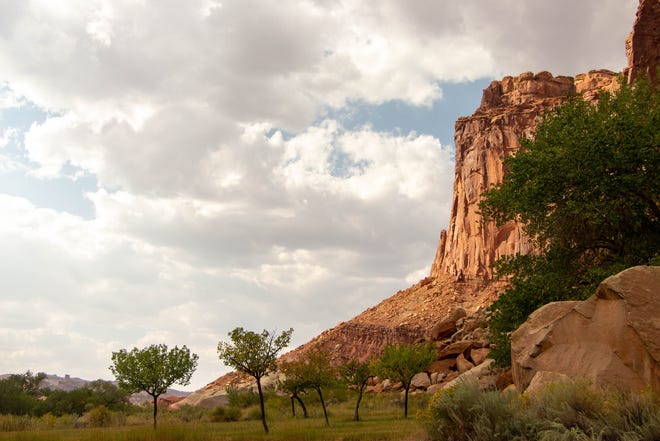
Unreal rock formations, looming cliffs and wide-open fields dot the way to Capitol Reef National Park. I’m telling you, driving between these parks is half of the experience.
As I pulled into the north-western entrance, I was again met with less pomp and circumstance than I am used to at Arches and Zion. But, I loved the intimacy and accessibility in Capitol Reef.
I felt so close to the rock walls, and the mid-day sun shining on the colorful contrast of red rock and green brush made me feel like I was in a painting.
A small log cabin caught my eye, it seemed so out of place and yet fitting as it snuggly nestled near the sharp cliff.
With my face and lens placed literally on the glass, I peered into the Fruita Schoolhouse. Strategically placed desks, pencils, blackboard and even a teacher’s apple transported into a different time when early Latter-day Saint settlers and their descendants tried to tackle the harsh desert terrain.
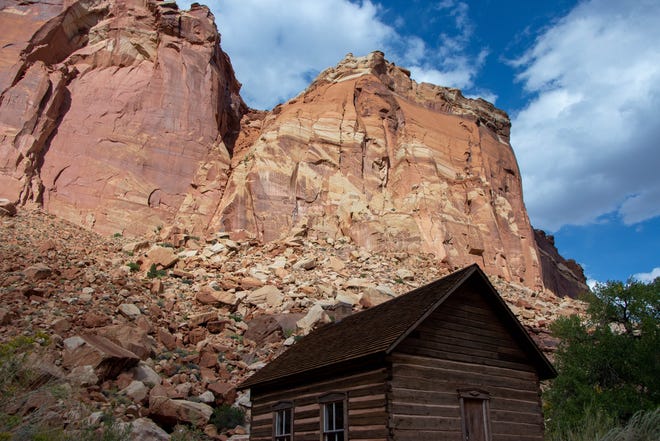
The orchards nearby made me forget I was in a desert, however, with the invitation to pick your own fruit announced on signs everywhere, though there was no fruit to pick at the time.
I ended my time in the lovely Capitol Reef with a stop at the visitor’s center and was immediately reminded of how Superintendant Sue Fritzke said the parking lots are a main point of congestion in the park.
Built in the ’60s, the parking lots in Capitol Reef are in desperate need of an update with limited space and virtually no space for oversized vehicles, like RVs.
MORE ON CAPITOL REEF PARKING LOTS: Is the lack of a public transportation system in southern Utah hurting citizens and tourism?
The visitor center itself is getting an upgrade, and while the main building is closed, a makeshift store with a ranger desk sits in the already limited parking lot in a trailer.

A ranger stood outside the trailer, monitoring how many people he let inside due to COVID-19 restrictions.
Where I had been slowly forgetting how our society has changed during the pandemic the past day and a half, this was a stark reminder of how life is different now.

In Torrey, the gateway town to Capitol Reef, I found solace in good old small-town America. Downhome restaurants, big backyards, small grocery stores and few gas stations greeted me and took me back to my roots.
However, Torrey thrives on tourist funds and as such is filled with trinket shops, hotels and attractions.
But I was there to talk about the mail.
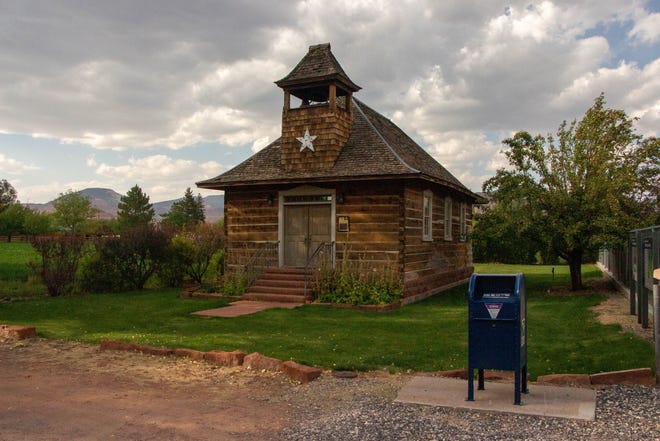
Torrey does not have a post office after it closed due to debt on New Year’s Eve. Because of this, residents have to drive to Bicknell, eight miles away, to retrieve and send mail.
I spent some time at the abandoned post office and the Bicknell post office, contemplating how this happened and what impacts it had.
MORE ON TORREY: ‘They’re holding the mail hostage’: Town in vote-by-mail Utah lost its only post office
Then, to Bryce before sundown.
Bryce Canyon National Park
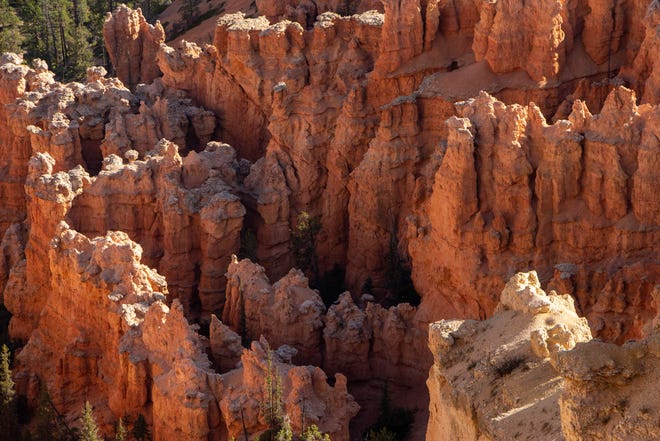
The road from Capitol Reef to Bryce Canyon National Park is paved with the soul of Utah, and America.
Winding roads, hearty small towns, ranches and open ranges dotted with livestock, more trucks than I could count and truly incredible scenery will meet you as you drive the two hours between the parks.
I was nearly in tears by the scenery on Johns Valley Road. I swear, if I could have closed my eyes for just a moment I would be in an old western, riding my horse into the sunset.
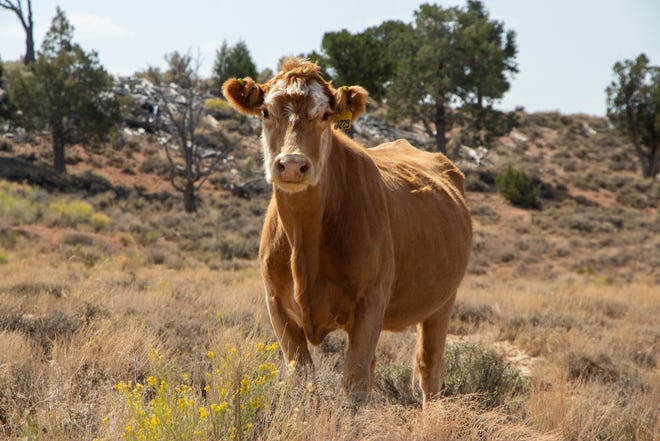
As kitschy as that may be, I genuinely felt connected to my roots and was truly proud to be a born and raised Utahn. The greenery, rock walls and steep mountains filled me with pride and wonder.
I landed back on Earth in Bryce, where I bounced along the bumpiest road I’ve ever driven on to stare at the Milky Way with Dark Ranger Telescope Tours just a few miles outside the park.
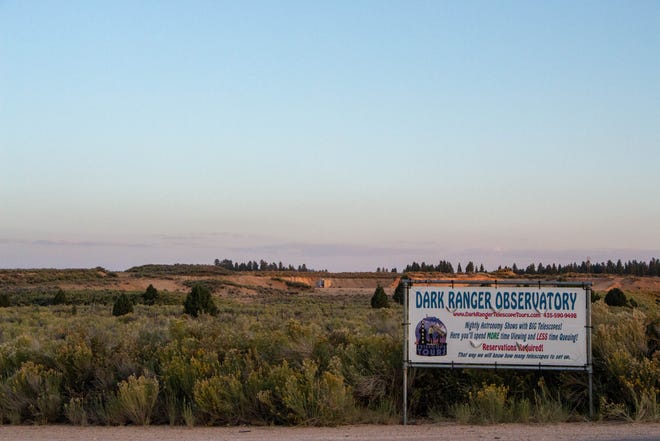
There, I swaddled myself in a jacket and blanket for the first time in months as I got a crick in my neck staring at the sky. I had forgotten what it was like to be cold.
As Bryce Canyon is one of the International Dark Sky Parks certified in Utah, I had to get a chance to see the Milky Way while I still could. Dark Sky certifications are constantly threatened by light pollution, and I did not want to be counted as one of the many millennials who have never seen the galaxy.
After four hours of nerdy, stargazing fun, I crawled back to my hotel in the nearby gateway town of Tropic and realized that with all that driving and all the fun I had, I forgot to eat dinner.
In the morning I scoped out local attractions such as the famous Ruby’s Inn and Restaurant, a city unto itself in Bryce.
Early morning among the pines was slow going and peaceful as I stood, jaw wide open, and looked at the canyons full of hoodoos and unbelievable rock formations.
That was, until I met the chaos at Sunset Point.
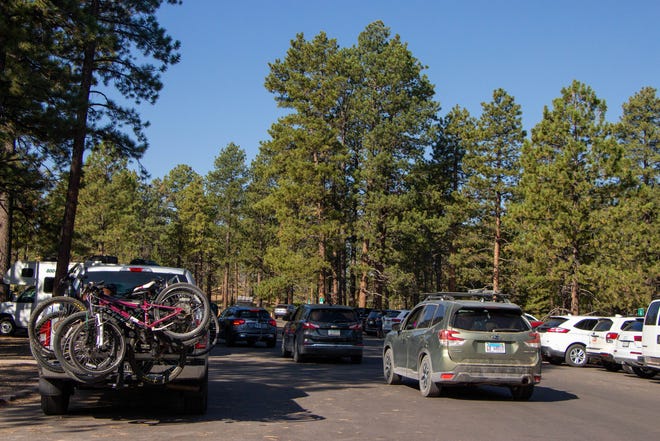
I went around the parking lot four times with no luck in finding a space. Rangers monitoring the lot shrugged and said this was normal for 9 a.m. on a Sunday. I should have taken the shuttle.
After scoping out the shuttle’s COVID-guidelines, some time at the visitor’s center with an open museum portion and breakfast at a good old western restaurant, I headed to scope out a ghost town.
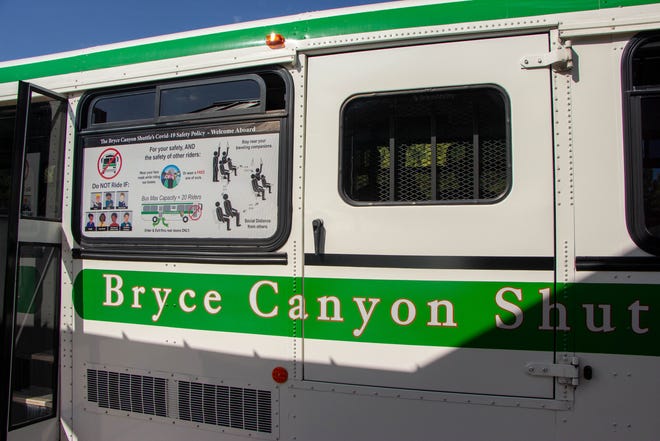
Being a professional snoop is part of my job, honestly. And as I pulled up to Widtsoe just 20 minutes outside the park, I was met with a scene frozen in time and just had to get inside.
Caved in floorboards, falling ceilings, rusting cans in the yard and holes from gunshots in the walls greeted me as I wandered into Widtsoe. It was deafeningly silent with just the shutter of my camera placing me back in the present.
That, and the obviously new cabins looming over the area.
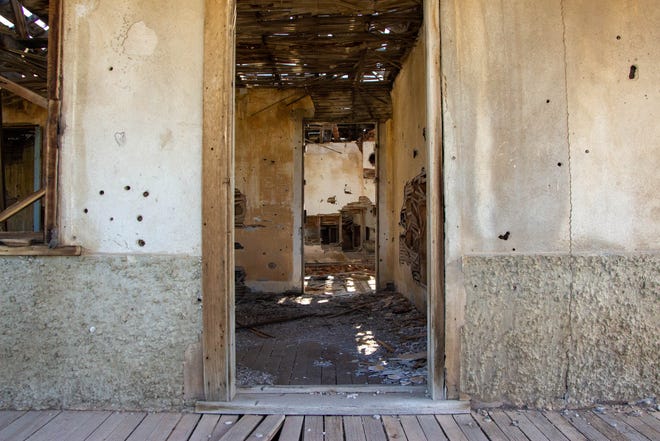
As I was snooping, a car pulled up to me and I thought I was for sure caught in the action.
But it was a sweet couple from Gunnison, who came to see if they could find any remnants of the husband’s parents, who were born there at the beginning of the twentieth century.
They were looking for a log cabin, long since gone, and any indication of roots. We laughed, held a genuine connection and again I remembered why I do this job. To learn of and tell stories. It is a privilege.
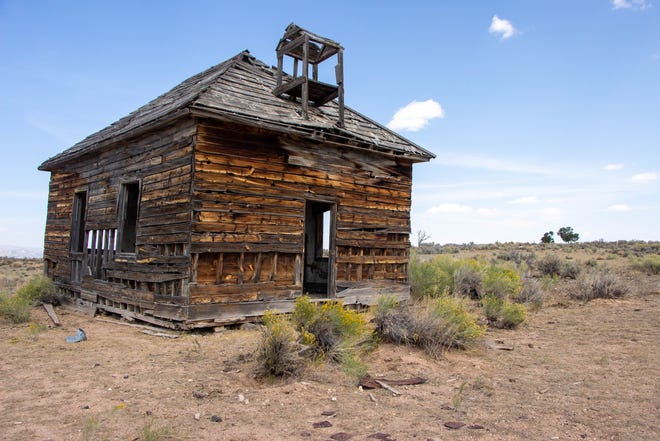
I walked over to the church or schoolhouse building, rotting and in decay.
Graffiti was etched on the wood inside as the whistle of the wind through the holes in the walls sent a chill down my spine. I sang a hymn, echoing off what walls were left, said a prayer and left the town, looking back in reverence. It was Sunday, after all.
Zion National Park

The road to the east side of Zion is more familiar to me than the journey I’d had the past few days.
Turning out of Orderville and onto the rollercoaster road into Zion’s east end, I thought it a pity that so many of Zion’s visitors come only through the south entrance in Springdale.
From Mt. Carmel to the Checkerboard Mesa, there are wide open spaces and isolation as you’ve never experienced. The Mesa itself looks almost alien, and I forget how incredibly unique they are while overshadowed by many of the attractions more central to the park.
And then, the tunnel.
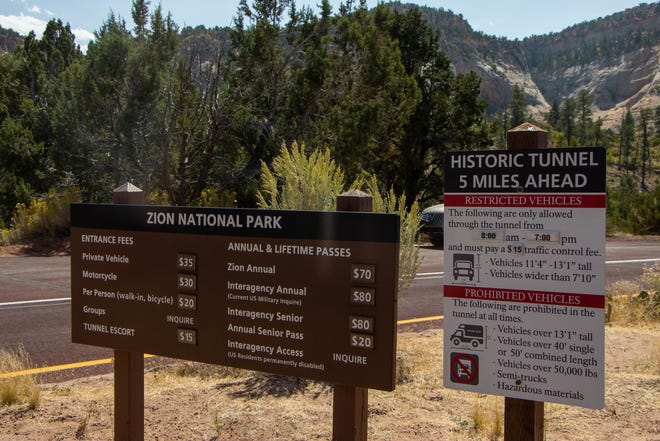
Mt. Carmel Tunnel is a chokepoint for all traffic trying to get from one side of the park to the other, with only one direction of traffic allowed at a time when any oversized vehicle requires an escort.
While my wait was only 15 minutes, in my past reporting, officials, advocates and visitors alike express deep dissatisfaction and frustration with the traffic through the tunnel.
Utah Clean Cities is aiming to put an electric shuttle through the tunnel, however, hoping to relieve some of the congestion. The project, as well as bigger plans to expand a shuttle system to St. George and beyond, is still in the beginning stages, but I am monitoring its progress as it goes.
MORE ON THE SHUTTLE PROJECT: A St. George-to-Zion shuttle could be key to unlocking Southern Utah public transportation
As I wrapped up my trip and chugged home, flopping exhaustedly on my bed at 4 p.m., I was reminded how lucky we are to live in a state with such extraordinary outdoor spaces.
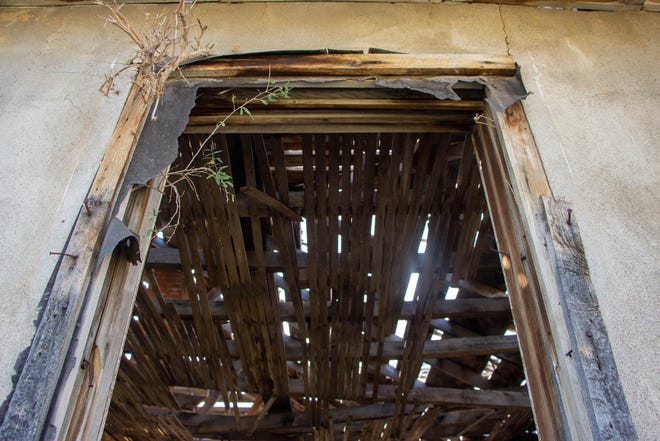
The people also seeking an escape from this tumultuous world like me were one of the best parts of the trip. I remembered that even though our life looks different now after COVID, some things are still the same.
Nature is the same. Human wonder and need for adventure are enduring. Human connection still exists. And most importantly, the human need to be united with the land will never go away.
In three days, I had traveled to alien planets, ghost towns, the stars, the center of the Earth, and ultimately, the center of me.
K. Sophie Will is the National Parks Reporter for The Spectrum & Daily News through the Report for America initiative by The GroundTruth Project. Follow her on Twitter at @ksophiewill or email her at kswill@thespectrum.com.
If you appreciate my work, please subscribe to The Spectrum and donate to Report for America by The GroundTruth Project.


lindasecrist.com
Linda Secrist’s Salt Lake City Real Estate Home Page • Salt Lake City Real Estate • Draper Real Estate • Holladay Real Estate • Sandy Real Estate • South Jordan Utah Real Estate • Salt Lake City’s Top Real Estate AgentLinda Secrist & Associates is the top selling team in luxury homes in the SLC Market. They have received countless awards over the past 20 years, including “Sales Team of The Year” for over 10 years including 2019! Linda Secrist is #54 in the top 100 Agents in the World in luxury residential real estate. If you’re searching for homes in Sandy, Salt Lake, Cottonwood Heights, Millcreek, Draper, South Jordan, Bountiful, Centerville, Farmington or anywhere in northern Utah, Linda Secrist & Associates are the real estate agents to call. If you’re buying or selling a home, don’t hesitate to text or call us at 801-455-9999!

